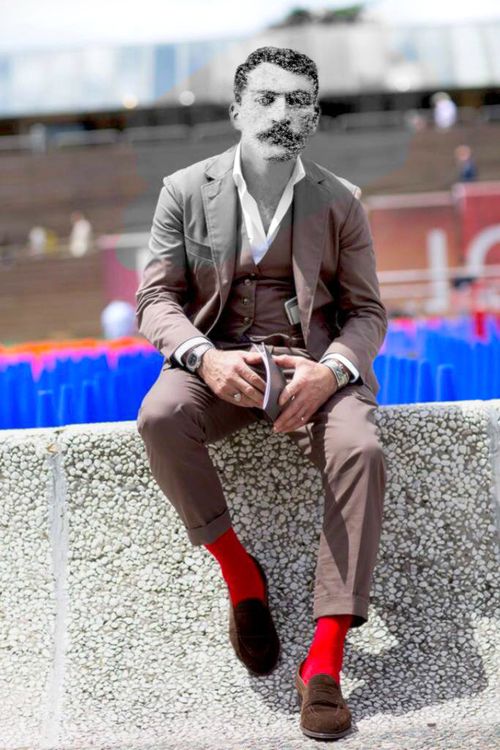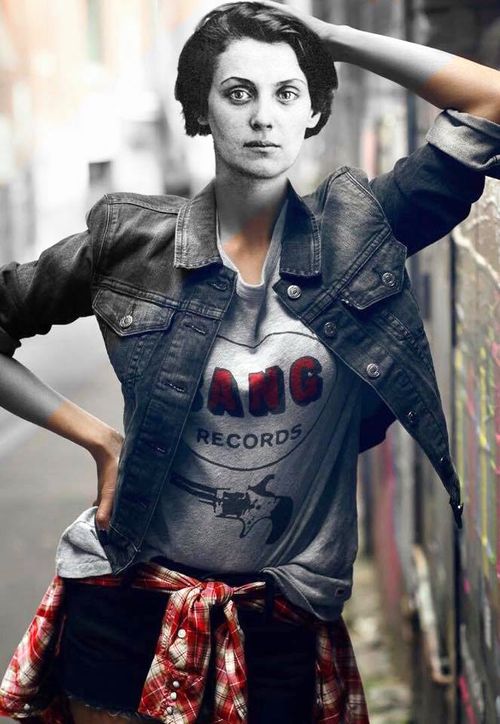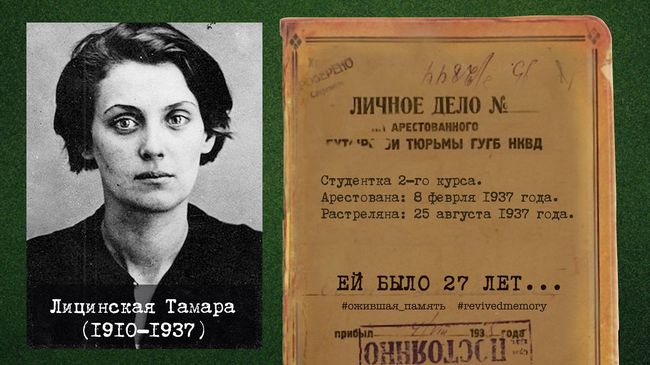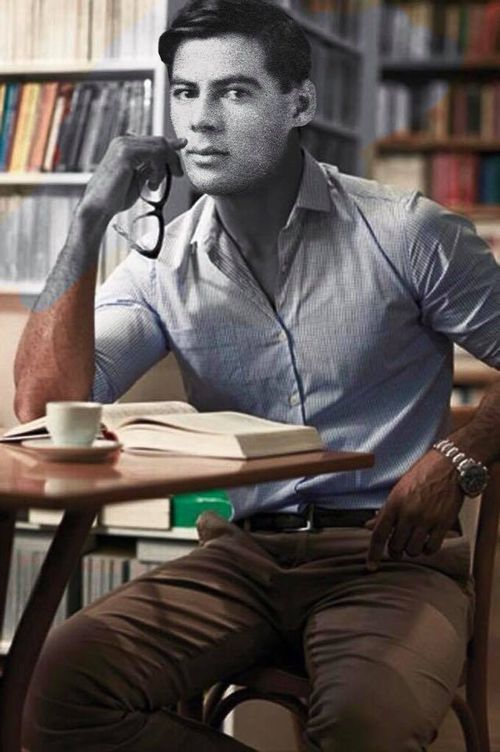People from the past, so very much like us today
Russian artist Hassan Bakhaev places Great Purge victims in modern setting
Raisa Bochlen, a typist with the Glavsevmorput [Soviet bureaucratic acronym of the Chief Directorate of the Northern Sea Route. – Ed.], was arrested and then executed on charges of espionage for Japan in 1937. The whole case was completely and hair-raisingly absurd. She is young, pretty, and very much alive, standing on the street in a motley, then trendy dress, in Moscow-based artist Hassan Bakhaev’s collage.
Hassan Bakhaev uses old black-and-white photos with victims of the Great Purge [a.k.a. the Great Terror], also modern pictures. It all started when he saw a photo of Tamara Litsinskaya on Facebook’s “Immortal Barrack” page. She was shot by an NKVD firing squad when she was 27 years old. He made several collages with Tamara and other Great Purge victims. He posted them on the eve of the Day of Remembrance of the Victims of Political Repressions and received 19,000 “likes” and 12,500 reposts. People wrote from various continents, sharing their old, yet still disturbing memories.
In fact, responses to his project ranged from praise to accusations of sacrilege. The artist says those who accused him knew little about the subject. Others sent photos of their executed relatives for further projects.

Back in the 1930s, people often fell prey to the repressive government machine due to tragic coincidences. Some would crack the “wrong” kind of joke at the office, others would treat someone living next door in manner that offended the neighbor – in each case letters were written and sent to the NKVD [and arrests, GULAG or a firing squad followed]. When I met with Hassan Bakhaev, we mostly spoke about happy coincidences due to which his Facebook project had evolved as one entitled “Memory That Has Come Alive,” turning hair-raising statistics into life histories, telling about those people who were so very much like us today.
FACES THAT LOOK MORE MODERN ARE PREFERRED
Mr. Bakhaev, you wrote that there were a lot of coincidences involved in your project, including the very idea. Anyway, you must’ve taken an interest in the history of [Stalin regime] purges.
“I certainly did. I take a liberal stand and I’m scared by such phenomena. Past and present, they make me feel very uncomfortable. There is also the matter of empathy. I’ve spent quite some time studying historical data. I’m not a researcher, but I signed in for the ‘Immortal Barrack’ page. My great- and grandparents were victims of the Great Purge, so this topic is close to me.
“However, conceiving the idea of the project was nothing but a coincidence. Another coincidence was that I made the project two days before the Day of Remembrance of the Victims of Political Repressions marking the 80th anniversary of the Great Purge. I had no idea at the time and posted the first collages on October 26. On October 29, I learned that October 30 was the date.
“Other coincidences would follow. Recently, I received a message from Irish musician and actor Steve Wall. He said he was impressed, that he had seen Tamara Litsinskaya’s photo and that it had inspired him to record a single with his rock band, The Stunning. In fact, he used practically the same words I’d used two weeks before, when being interviewed by various channels, among them Dozhd.

A COLLAGE WITH TAMARA LITSINSKAYA AND HER PHOTO THAT STARTED THE PROJECT “MEMORY THAT HAS COME ALIVE.” HASSAN BAKHAEV MANAGED TO MEET TAMARA’S GREAT-GRANDDAUGHTER WHO LIVES IN BELGIUM AND WHO LIKED THIS WORK

“I had to make a separate page for the project because the amount of responses was way above my boldest expectations. Lots of ‘likes’ came as a very pleasant surprise, although some called into question the project’s ethical aspect. That was something well to be expected. People tend to discuss subjects they know – or care – little about. None of these critics had any relatives as victims of the Great Purge.
“On the second day after posting the collages, I found myself in touch with a lady in New Zealand. She was born in what was then Czechoslovakia and was now a human rights activist. She invited me to stage an exhibit in New Zealand. We agreed on technical arrangements and she said she’d get in touch with a friend in Germany to clarify certain aspects. The next day she wrote that when she’d sent the files to her friend, he replied that he knows Tamara Litsinskaya’s great-granddaughter who lives in Belgium, that her name is Anna Buyevich, that she is a musician, and that they had studied at the same institute. He then showed her the photos, we got in touch, and I asked if she liked the project. She replied that she did, and that she thought her grandmother Tamara would have approved.
“Events appear to be taking place to help with the project. I had an interview with a German from Channel ARTE. By then I’d realized that I need archival data and was trying to figure out the sources. It was then the German journalist called, asking for an interview. I explained the situation and he promptly got me in touch with the Memorial [a Russian historical and civil rights society that operates in a number of post-Soviet states. – Ed.]. They provided me with the data I needed. See, one thing leads to another…”
What are your criteria when choosing a photo for your collage?
“The whole project was inspired by Tamara Litsinskaya’s photo. Her face. There were also photos with young attractive people. I found myself wishing to make a collage or two. Youth and physical attractiveness are always very strong factors (although I’m now focusing on older people). In my case, their life histories weren’t important because they were very much alike – regardless of their social status and occupation, be it a metalworker, plumber, whatever – they were all arrested on absurd charges and executed.
“I choose photos with faces that look more modern, that can be placed in the modern setting. There are faces best described as being out of time, they are so charismatically beautiful. Well, I can do only so much. In order to convey the horrors of that period, I have to use images that are easily identified by the current viewer. People realize that there is a brief historical period between what happened then and what’s happening now, that those young men and women who fell prey to the Great Purge were practically no different from their counterparts today. My project was aimed at conveying this message – and it proved a sudden success.”
Did you include photos of your purged relatives into the project?
“I have a photo of my maternal great grandfather by the name of Sergei Malolichenko and I’ve included it in a collage. He wasn’t shot but died of some disease in a prison camp. The photo is of a very poor quality, so I’ll have to work on it. I included and posted it because some wrote that I wasn’t involving my relatives…”
GREAT PURGE THEME: STILL TOPICAL
How are you handling modern photos?
“I download them, lots of them on the Internet. I choose people by complexion. As an artist, I can see what face, physique, and angle is right. When I put all this together, the images appear to come alive. I deliberately keep the faces in black-and-white. First, I didn’t know how to work the colors when I started on the project, so that was the only solution to the problem. Later, this approach proved the only right one, as it erased the difference between the black-and-white and color photos, producing an unusual effect. Otherwise, faces in the color photos would be just faces in regular color pictures.”
You’re receiving messages from various countries. Do you think that the Great Purge theme is still topical?
“It has always been topical in Russia. There are many people whose relatives were purged. I’ll always remember my relatives. You know what this so-called post-Soviet space looks like. Look at the rest of the world. They’re having their own problems, lots of grief, what with oppression of fellow humans and negligent attitude to their lives. Or take the Holocaust. People who know its history, who know about all those fellow humans who found themselves in the Nazi concentration camps, take this topic close to heart. Memories are still there, so this theme remains topical, considering the messages I’ve been receiving.”


You say that this theme remains topical in Russia. Indeed, there is the annual Return of the Names ceremony [a day-long rally held October 29, with posters and photos, reading out the victims’ names. – Ed.] by the Solovetsky Stone on Lubyanka in Moscow. At the same time, monuments to Stalin are being unveiled in various [Russian] cities. A recent Levada Center poll shows that such projects are being supported by an increasing number of Russians. How would you explain this trend?
“This double social standard in Russia can only scare me. It’s an oxymoron. People often find themselves exposed to the Stockholm syndrome. It’s like a genetic code when people can’t think independently, when they can’t retain their individuality, when they can’t help following the crowd, taking orders from some leaders (preferably uncompromising and ruthless ones). If such a leader fails to pass muster, they proceed to build his idol-like image.
“Any given society is divided into categories. There are thinking communal members in Russia. They are currently referred to disparagingly as liberals. These individuals are capable of thinking things over and analyzing them critically. Here the academic background doesn’t matter; it doesn’t serve as evidence of intellect. I’ve often heard from people who considered themselves to be scholars that Joseph Stalin, despite the horrors of his regime, ‘took over a country where the plow was predominant and left it with an A-bomb.’ Flag-waving patriots, for all I know. Using cat’s paws is good, of course. I wish those who say that the White Sea–Baltic Canal [popularly known as the Belomorkanal, built with the sweat and blood of GULAG inmates back in 1932; also long since the most popular Soviet cardboard holder cigarette brand. – Ed.] was a good project had taken part in it, leaving their bones there. Then views on the matter would have been different. The revolution devours its children [wrote Royalist journalist Mallet du Pan during the French Revolution. – Ed.]. So many of those who used to march in columns to attend another congress of the Communist Party, clapping their hands and cheering every resolution from the rostrum, would end up in front of a firing squad. I can only say hello to all those idiots without historical memory – due either to lack of education or low IQ. Sooner or later, the government machine will crush them, because if this machine is allowed to function without public control, it will spare neither the leftists, nor the rightists. It will destroy anyone who gets in the way.”
Getting back to project “Memory That Has Come Alive,” what’s the status?
“It started on the spur of the moment and is evolving the same way. I’m collecting data. I already have 20 characters, but I want between 40 and 60, then I’ll stage an exhibit. A friend of mine is negotiating the project with some Moscow museums. I believe that the exhibit will be ready in a month. I’ve been invited to stage it in Frankfurt – I think that people of good will are interested in it. Most importantly, they understand its importance and use for the generations to come.”






